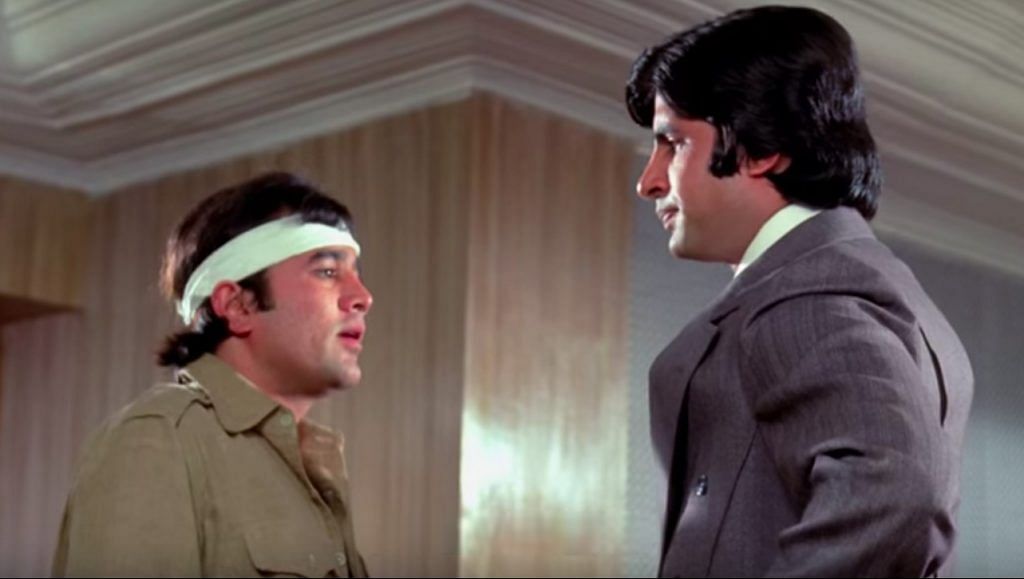Actor Amitabh Bachchan has completed his 50th year in Hindi cinema. A five-decade-long career is not a common event in any profession, especially in cinema. To last this long and still be one of the most sought after is even rarer. His career in Bollywood is more of public history now. What started in 1969 is the country’s legacy today.
Director Hrishikesh Mukherjee had managed to bring the two together again after the now-cult Anand (which had released two years earlier in 1971). In Anand too, Amitabh Bachchan plays the perfectly stoic foil to Rajesh Khanna’s dramatics.
More a didactic political argument than anything else, Namak Haraam was unlike any other Hrishikesh Mukherjee film. The director of gentle comedies or sensitive character studies had made a decidedly political film.
Even as it was a successful venture at its time, Namak Haraam gained more prominence retrospectively mainly because of the signifier it became in the careers of both Amitabh Bachchan and Rajesh Khanna. Coming after a record number of successes, Khanna’s halo had just started to fade a little. Bachchan’s stock had just started to rise — Prakash Mehra’s Zanjeer had released earlier that same year and there was no looking back.
These completely external factors make Namak Haraam a strange viewing experience today because the film is primarily an exercise in pitting two men opposite each other.
Also read: Aradhana propelled Rajesh Khanna to his ‘15 hits in a row’ superstardom
Set against the backdrop of the ongoing conflict between the industrial mills and workers’ union across the country, the 1973 film is about two best friends who find themselves on the opposite sides of the moral and ideological line separating the mill workers and the mill owner.
Vicky (Bachchan), the only possible name for rich on-screen brats before the Malhotras arrived, and Somu (Khanna), a curiously unique name for a Hindi film character, take their arcs from the Indian legend of Krishna and Sudama.
Playing the poor-little-rich-boy, Vicky lives a wealthy but lonely life and craves affection and friendship, both suitably taken care of by Somu, a lower-middle-class boy, and his family.
The plot kicks in when Vicky, asked by his father to run the family-owned mill, is ‘insulted’ by union leader Bipin Lal (A.K. Hangal, being his usual genial self). Vicky’s ‘hurt’ is so severe that he cries in front of Somu who can’t see anything but his friend’s tears. So, he plots revenge. He takes up an undercover job at the mill and slowly wins the trust of the workers only to dislodge Lal. That’s it.
Except, by the time he cunningly sends Lal packing his bags, he has seen too much poverty and misery to turn his gaze away. This evolution frames the film’s argument.
https://www.youtube.com/watch?v=PleWU2pdK-I
Bombay, as the city was called then, had seen a violent decade in the 1960s (refer Anurag Kashyap’s underseen Bombay Velvet) owing to a vicious battle between mill owners and workers’ unions. In its overt and stated outlook, the Mumbai film establishment was unequivocally socialist till the early 2000s, never mind the subtext suggesting a wish for a more capitalist system. Mukherjee, like his mentor Bimal Roy, was also a socialist.
While most of his cinema was personal in nature, Namak Haraam was an outlier, and frankly, not much of an original comment either. It was simplistic even by Hindi film standards.
But close to five decades later, it’s still a reasonably fun watch, although not necessarily in the manner conceived.
Before he became the face of India’s angst as the Angry Young Man, the character to which Somu was a precursor, Bachchan was struggling to find his own space. Even then, he appeared head and shoulders above his contemporaries. Nowhere was that more evident than in Namak Haraam. Khanna was a ‘stylist’ and that style, despite its unprecedented popularity, became staid very quickly.
Also read: No jobs then, no jobs now: Gulzar’s 1971 film Mere Apne still rings an unfortunate bell
The Khanna-vehicle Anand seems to be years removed from Namak Haraam.
https://www.youtube.com/watch?v=17AXtxleQZk
In a film as moralising as this, where characters mouth lines that don’t necessarily sound life-like and the pitch is always too elevated, it’s easy to turn in a performance like Khanna did. Give what people want — the bobbing head, the twinkling eyes, the ‘mannerisms’.
But Bachchan, in a ‘supporting’ part, stood out because he could latch on to the heavy pitch of the film with his now-trademark baritone and a difficult-to-manage subtlety without sacrificing character. The charisma was inbuilt. So even when the twists become too jarring, one remains invested.
Khanna was the lead in Namak Haraam in the conventional sense — he got all the musical hits in the film from composer R.D. Burman who was then at the peak of his powers. (From ‘Diye Jalte Hain’ to ‘Main Shayar Badnaam’, it was a Kishore Kumar festival, the film.)
But Amitabh Bachchan ‘stole’ the film, and given how life played out later, one might say the crown as well.
